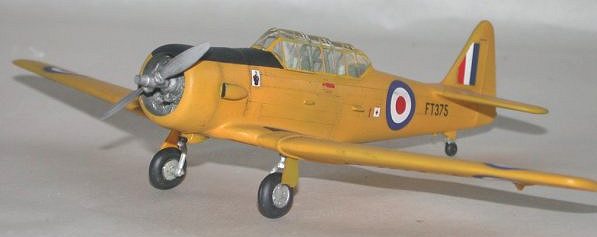
Airfix 1/72 Harvard II
|
KIT # |
? |
|
PRICE: |
NZ $8.95 |
|
DECALS: |
Two aircraft |
|
REVIEWER: |
|
|
NOTES: |
South African boxing. |

|
HISTORY |
The Harvard
must be considered one of the outstanding aircraft of World War II and the early
postwar years. From 1940 to 1955, nearly all American and British Commonwealth
pilots received some training on Harvard’s. Strong yet unforgiving,
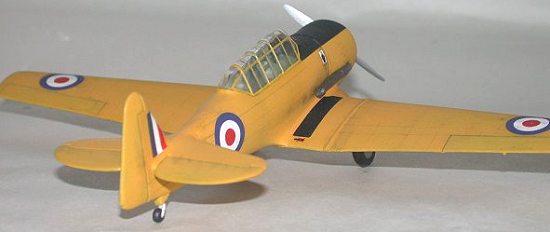 requiring a
delicate touch to keep straight during landing and take-off, it was an ideal
training airplane. Canada built more Harvard’s than any other aircraft, with a
total of 3 350 produced. In anticipation of a possible aluminum shortage, a
wooden rear-fuselage and set of wings were developed and built, but not
produced. Gunnery trainer and target tow versions were also developed but never
produced.
requiring a
delicate touch to keep straight during landing and take-off, it was an ideal
training airplane. Canada built more Harvard’s than any other aircraft, with a
total of 3 350 produced. In anticipation of a possible aluminum shortage, a
wooden rear-fuselage and set of wings were developed and built, but not
produced. Gunnery trainer and target tow versions were also developed but never
produced.
Note: Paragraph plagiarized from http://www.aviation.nmstc.ca
Harvards were used By the RNZAF as an advanced trainer in WWII and were only retired from active RNZAF service in 1977, They are in great demand these days as entry level Warbird aircraft and as members of the famed “Roaring 40’s” Wanaka Warbirds aerobatic team.
|
THE KIT |
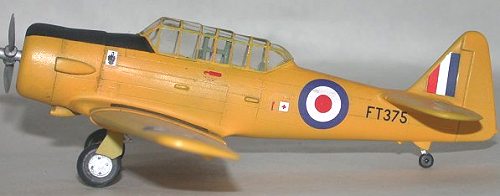 The Harvard is
Classic Airfix straight down the line with it’s oversized rivet detail and
raised panel lines, basic detail and nothing in the way of cockpit detail, yet
the basic shape is accurate and with a little work a nice little model is
achievable.
The Harvard is
Classic Airfix straight down the line with it’s oversized rivet detail and
raised panel lines, basic detail and nothing in the way of cockpit detail, yet
the basic shape is accurate and with a little work a nice little model is
achievable.
Moulded in the now standard Gray plastic with most of the parts broken off the sprue and rattling around in the box and like most Airfix moulds showing it’s age with short shots and sink marks abound. No interior detail is provided unless you count the two pilots precariously perched on a couple of generic seats, toy wheels and a free floating thick, cloudy and scratched canopy completes the line-up. Instructions are the typical multi-lingual exploded diagrams that are now the norm, mind you, instructions are not normally needed for 1/72nd scale Airfix kits.
|
CONSTRUCTION |
With that huge canopy and no detail I decided to at least give the impression of an “office” , a few months ago I perfected a cheap way of casting small bits like sidewall panels and instrument panels without the mess and expense of resin. By using a hot glue gun and Car auto filler I can churn out as many copies of the one set of resin sidewalls I have. Granted all my aircraft have P-40 Warhawk cockpit detail but in 1/72nd scale I go for the impression rather than total accuracy.
A 10 thou
floor was added along with scratch built seats, my homemade sidewalls were added
along with plenty of stretched sprue added to depict the roll cage. instrument
panels were cast and added and seat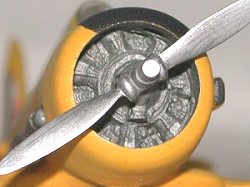 belts made from the lead foil off a good
bottle of Kiwi plonk. All rivet detail and raised panel lines were sanded off
and an attempt was made to rescribe some panel detail, I really suck at
rescribing and without fail make a mess of it but the overall effect looks
better than those golf ball sized rivets.
belts made from the lead foil off a good
bottle of Kiwi plonk. All rivet detail and raised panel lines were sanded off
and an attempt was made to rescribe some panel detail, I really suck at
rescribing and without fail make a mess of it but the overall effect looks
better than those golf ball sized rivets.
Construction was straight forward with very little filler needed, more filler was needed to fill the sink marks than was needed on the joints. Two points to watch for is on the fuselage locator pins, front and rear, both having very deep sink holes. The one piece cowling and engine came under the knife next, by drilling out the Airfix engine and replacing it with a home cast engine a better detailed nose resulted, granted a replacement resin/white metal engine would look even better but mine cost nothing and It’s fun playing with Auto filler!
The appearance of the exhaust pipe can be improved by carefully drilling out the hollow end. Wheels on just about all Airfix models look “toy like” but with nothing better in the spares box I had to run with what I had.
|
PAINTING & MARKINGS |
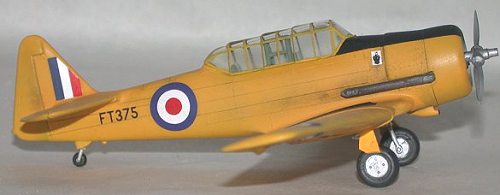 Instructions
give decals and colour schemes for two Harvard II’s, The first is a Silver
Harvard from 1340 FLT RAF 1954 that was unusual in the fact that it had a .303
machine gun in the starboard wing and was fitted with bomb racks, The second and
one I chose to do is a overall Yellow Harvard from RAF Boscombe Down 1978.
Instructions
give decals and colour schemes for two Harvard II’s, The first is a Silver
Harvard from 1340 FLT RAF 1954 that was unusual in the fact that it had a .303
machine gun in the starboard wing and was fitted with bomb racks, The second and
one I chose to do is a overall Yellow Harvard from RAF Boscombe Down 1978.
First job was to spray an undercoat of white and once that way dry light coats of Humbrol flat yellow was misted over the Harvard until the desired colour coverage was achieved. Control surfaces were masked off separately and sprayed a slightly different shade of yellow to depict a canvas surface. A week later the black anti-glare panel was masked off and sprayed Tamiya flat black.
Two coats of Future were laid down for the kit decals which settled down well using a potent homebrewed decal softener that makes Micro-sol look like water. The black Wing walk area’s were added from black decal strips. Once the decals had dried and the excess decal softener was washed off a couple more coats of future were added to level off the decals and seal them in.
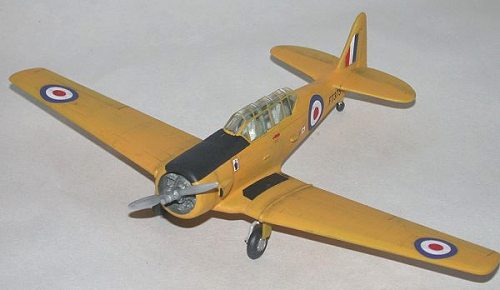 Flown back to
the paint shop a few days later the first coat of Humbrol Dull Kote was sprayed
on. Weathering and post-shading was done using chalk pastels which I am really
beginning to like as a weathering tool. I find them far easier to use than oils
and more forgiving as If you over do it you can remove it with plain old water,
Once the weathering was done one more light coat of matt was misted over to seal
the pastels.
Flown back to
the paint shop a few days later the first coat of Humbrol Dull Kote was sprayed
on. Weathering and post-shading was done using chalk pastels which I am really
beginning to like as a weathering tool. I find them far easier to use than oils
and more forgiving as If you over do it you can remove it with plain old water,
Once the weathering was done one more light coat of matt was misted over to seal
the pastels.
Final details like undercarriage and Propeller were then painted and installed. The badly scratched canopy was polished and “Futured” which helped a lot with the clarity.
One thing I did stuff up was I didn’t check the fit of the canopy before painting the plane and on mating it up to the fuselage discovered that even though it fit well with no gaps it was a tad too long and over-hung the rear by a touch. To fix properly it would mean faring in the rear with lots of filler. ah well maybe on the next rebuild.
|
CONCLUSIONS |
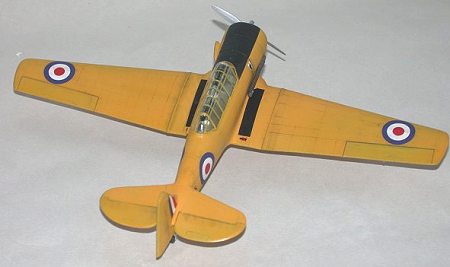 The Airfix
Harvard II has since been superseded by the very nice Acadamy version and most
modelers would not bother with the Airfix offering as it stacks up rather poorly
against it. Airfix (and Airfix quality kits) has been and still is my staple
diet for years. I’m one of these weird modelers that will pass by the Tamigawa
Fruitbat wunderkit and go straight to the Older crude Revfix version because
that’s the enjoyment I get out of this hobby.
The Airfix
Harvard II has since been superseded by the very nice Acadamy version and most
modelers would not bother with the Airfix offering as it stacks up rather poorly
against it. Airfix (and Airfix quality kits) has been and still is my staple
diet for years. I’m one of these weird modelers that will pass by the Tamigawa
Fruitbat wunderkit and go straight to the Older crude Revfix version because
that’s the enjoyment I get out of this hobby.
There is nothing really wrong with the Airfix Harvard there is just a better kit available now, recommended for eccentric kiwi’s and a trip down memory lane.
My thanks to Keith Page for the Kit.
|
REFERENCES |
http://www.aviation.nmstc.ca/Eng/Collection/sd088e.htm
New Zealand Aircraft Illustrated by Alan Knowles.ISBN 0-9597832-7-X
Copyright ModelingMadness.com. All rights reserved. No reproduction in part or in whole without express permission.
If you would like your product reviewed fairly and fairly quickly, pleasecontact the editor or see other details in the Note to Contributors.